 Welcome Guest Blogger Yvonne Drazic. She is a PhD candidate at James Cook University in Cairns, Far North Queensland, Australia. Her research focus is on reducing the rate of undiagnosed and untreated chronic hepatitis B, in migrant communities from endemic areas, particularly the local Hmong community. Yvonne lives with chronic hepatitis B, and feels privileged to be one of the less than 3% of hepatitis B cases treated in Australia. She gives back in so many ways, and is also a list parent on the HB-List, an online patient forum.
Welcome Guest Blogger Yvonne Drazic. She is a PhD candidate at James Cook University in Cairns, Far North Queensland, Australia. Her research focus is on reducing the rate of undiagnosed and untreated chronic hepatitis B, in migrant communities from endemic areas, particularly the local Hmong community. Yvonne lives with chronic hepatitis B, and feels privileged to be one of the less than 3% of hepatitis B cases treated in Australia. She gives back in so many ways, and is also a list parent on the HB-List, an online patient forum.
As a research student from tropical Far North Queensland in Australia, I am grateful that today’s technology allows me to be part of the global hepatitis B community. My goal is to help our local Hmong community of about 700 people to prevent future repercussions of undetected and untreated chronic hepatitis B (CHB). Having CHB myself, I was amazed to learn how many people miss out on vital medical care because they are unaware of their infection, or of its potential consequences. At present, the incidence of hepatitis B-related liver cancer is rising in Australia because undiagnosed CHB is doing much more harm than newly acquired infections in adults. The majority of affected people in Australia are migrants from endemic areas and Aboriginal and Torres Straits Islander people who were mostly infected at birth or in early childhood. Yet, less than 3% of cases are currently receiving antiviral therapy (Carville & Cowie, 2012).
I chose to focus on the Hmong community because studies in the U.S. show a particularly high CHB prevalence (~15%) in this population (Kowdley, Wang, Welch, Roberts, & Brosgart, 2011). And sure enough, when talking to members of the community, I heard sad stories of family members getting sick or dying from liver disease. Hepatitis B as a threat to public health has long been neglected in Australia, compared to the attention given to HIV and hepatitis C. However, based on a National Hepatitis B Needs assessment (Wallace, McNally, & Richmond, 2008) and other reports that showed an urgent need for a co-ordinated public health response, the first National Hepatitis B Strategy was finally released in 2010. The strategy highlights priority action areas such as raising awareness in patients and doctors, improving screening and diagnosis practices, and removing barriers in culturally and linguistically diverse (CALD) populations.
In Australia, pregnant women are routinely screened for hepatitis B. However, research suggests that many who test positive during pregnancy do not receive adequate follow-up care (Guirgis, Zekry, Yan, Bu, & Lee, 2009). In addition, recent studies indicate that CHB awareness is still low in Australian general practitioners (GPs), and that many patients are not managed according to guidelines (Dev, Nguyen, Munafo, Hardie, & Iacono, 2011; Guirgis, Yan, Bu, & Zekry, 2011). Therefore, in order to achieve improvements in early detection and timely referral for treatment, increasing GP involvement is a priority.
My project comprises (1) an assessment of knowledge, current practice, awareness of resources and educational preferences of local GPs; (2) assessments (pre- and post) and an appropriate intervention in the Hmong community (all based on behavioural theory); and (3) an assessment of pregnant women and new mothers. At the time of writing, data collection from GPs is under way.
Community engagement is, of course, an ongoing process. The project has the support of a community leader who is providing invaluable information about what may and may not work in his community. Initial information about the project was recently distributed. Building trust and showing that my motives are genuine takes time and it is important to let things develop instead of pushing ahead too fast. The fact that I have CHB myself may help to convey the message that it is okay and even necessary to talk about hepatitis B. Normalization assists in the removal of stigma.
More of my work to be shared in another blog. A big thank you to the special people who have been inspiring and encouraging me to do this work and keep offering tremendous, ongoing support.
Yvonne
References:
Carville, K. S., & Cowie, B. C. (2012). Recognising the role of infection: preventing liver cancer in special populations. Cancer Forum, 36(1), 21-24.
Dev, A., Nguyen, J., Munafo, L., Hardie, E., & Iacono, L. (2011). Chronic hepatitis B: A clinical audit of GP management. Australian Family Physician, 40(7), 533-537.
Guirgis, M., Yan, K., Bu, Y. M., & Zekry, A. (2011). A study into general practitioners’ knowledge and management of viral hepatitis in the migrant population. Internal Medicine Journal, Accepted article. doi: 10.1111/j.1445-5994.2011.02440.x
Guirgis, M., Zekry, A., Yan, K., Bu, Y. M., & Lee, A. (2009). Chronic hepatitis B infection in an Australian antenatal population: Seroprevalence and opportunities for better outcomes. Journal of Gastroenterology and Hepatology, 24(6), 998-1001. doi: 10.1111/j.1440-1746.2009.05841.x
Kowdley, K., Wang, C., Welch, S., Roberts, H., & Brosgart, C. (2011). Prevalence of chronic hepatitis B among foreign-born persons living in the United States by country of origin. Hepatology, Accepted preprint.
Wallace, J., McNally, S., & Richmond, J. (2008). National hepatitis B needs assessment. Melbourne: Australian Research Centre in Sex, Health, and Society, La Trobe University.

